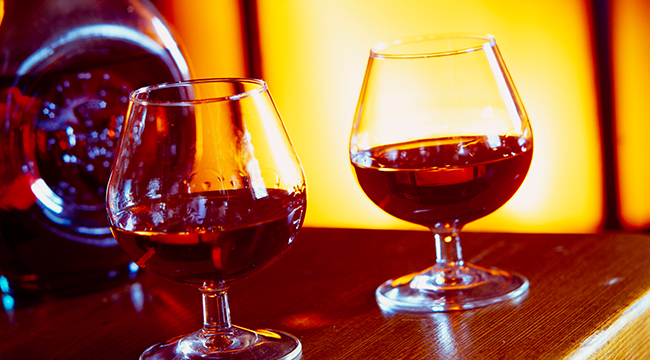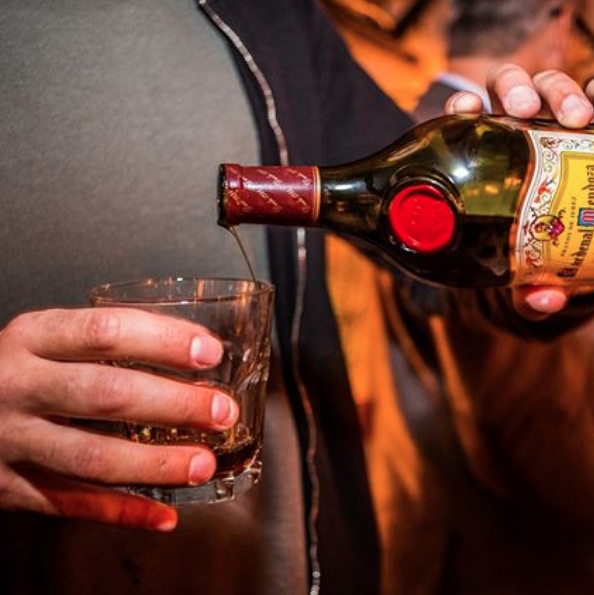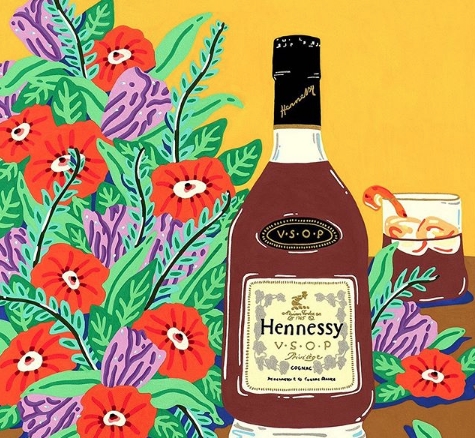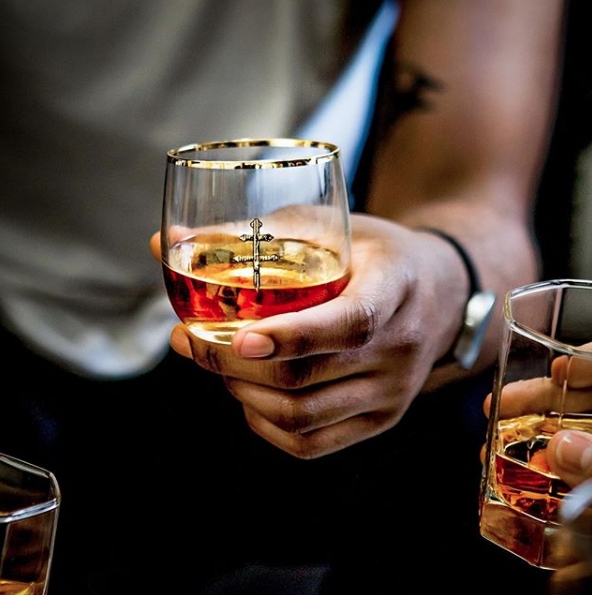
Generally speaking, brandy and cognac are often lumped together. This is understandable, given the similarities between the two spirits, but their differences are worth making note of. Depending on the distillery or even the particular bottle, you might see a massive chasm between the two or virtually no difference at all. It’s a matter of degrees, defined by the people crafting the bottles in question.
Before we can even dig in to these differences, it has to be said that brandy in general and cognac in particular were on the ropes by the 1970s. Their audience of after-dinner sippers was shrinking rapidly. Distilleries were closing left-and-right all over France, Spain, and further afield. Then along came the burgeouning hip-hop industry — offering lyrical shout outs to their favorite brands. Everything changed. The American market opened up. Exports skyrocketed.
Rappers straight up saved the booze from extinction.
Brandies and cognacs have since become an integral part of the hip-hop game with a very long list of rappers endorsing their own bottles. Jay Z (D’USSÉ, Armand de Brignac), Nas (Hennessy), Ludacris (Conjure Cognac), DJ Khaled (D’USSÉ), and a long list of others have bespoke bottles or custom brands. The throughline? Almost all of these bottles are French Cognac.
We digress. Let’s get back to the matter at hand. What’s the difference between brandy and cognac? We take a look at each style and dive into where they overlap and where they diverge.
Brandy Defined

Very simply, brandy is a distillate made from the mash (base ingredients) of fruit or vegetables, most commonly white wine grapes. Way back in the 1500s, monks distilled their wine so it could travel without spoiling. They called the stuff eau de vie, literally the water of life. They just so happened to store their wine distillate in barrels so they could take it with them while they spread the good word. You might call it divine inspiration.
Back in those days, the distillate was pretty harsh. Since the distilling process concentrated the alcohol and flavors, the spirit was meant to be cut with water to re-lower the ABV content (alcohol kick). But as the barrels traveled further and longer, the aging made the grape distillate too tasty to cut with water. Soon, monks all over Europe were tinkering with aging their brandies for longer and longer and in more specific woods.
This aging process across France eventually led to a designation process: V.S. (“very special”), V.S.O.P. (“very superior old pale”), XO (“extra old”), and Hors d’âge (“beyond age”). Respectively those designations denote at least two years in a cask, at least four years, at least six years, and, finally, at least ten years. You can think about brandy aging exactly like any whiskey, bourbon, or rum. The spirit goes into the wood barrels and immediately starts drawing sugars, colors, and flavors from the wood. Over the years, evaporation takes place concentrating those components until a master blender comes and creates the perfect balance for a bottle of great brandy.
What these designations often ignore is that brandy isn’t an exclusively French spirit. Spain and Germany also have huge markets for the brown stuff. Spain even uses its own age designation system — unique to their process and warmer climate. Brandy de Jerez Solera (at least one-year-old), Brandy de Jerez Solera Reserva (at least three years old), and Brandy de Jerez Solera Gran Reserva (at least ten years old). The first two designations are about a year shorter than in France. This isn’t due to the Spanish being impatient. It’s simply because it’s hotter in Spain. Comparably, tequilas in Jalisco or rums in Cuba need far fewer years in the barrel than Kentucky bourbon, simply because of the weather.
As for the mash, brandy can be made from pretty much any fruit or vegetable base. You can have plum brandy (slivovitz in Eastern Europe) or apple or pear brandy, beet brandy, and so on. These brandies tend to be single distilled from fruit pomace or juice and are rarely aged. These “fruit brandies” impart the essence of the fruit with a hefty alcohol kick. These interpretations couldn’t be further from cognac. Let’s dive into why.
Cognac Defined

There’s a rule in the agave spirit game: All tequilas are mezcals but not all mezcals are tequilas. This rubric applies here. All cognacs are brandies but not all brandies are cognacs.
First and foremost, “Cognac” is a regional designation, an appellation d’origine contrôlée in France. Like Champagne in Champagne (France) or Parmigiano Reggiano in Parma and its surrounding municipalities (Italy), to be officially and legally called that name it has to come from that place. So, our first step is that cognac is a brandy that has to come from the region around Cognac, France, namely Charente and Charente-Maritime.
The rules for cognac don’t end with where it’s made. The grape used has to be at least 90 percent Ugni Blanc, Folle Blanche, or Colombard — all locally grown white wine grapes. The remaining ten percent of the mix can be other local grape varieties like Folignan, Jurançon Blanc, Blanc Ramé, Sélect, Montils, or Sémillon.
From there, the grapes are pressed and fermented into a wine with local, wild yeasts from the Cognac countryside’s air. Then the wine is twice distilled in copper stills that also meet specific legal size requirements. The distillers end up with a 70 percent ABV drink that’s ready for the barrel.
The cognac then has to be aged for at least two years in French Limousin oak. As the oak and air do its thing — flavoring, coloring, and concentrating the cognac — evaporation takes place. Eventually, the cognac reaches 40 percent ABV (alcohol and water evaporate over the years) and is transferred to a glass tank. Once there, blenders come in and create the perfect balance to be bottled and sold to the public.
This is where the brand and age come in. Houses like Hennessey or Remi Martin have master blenders who purchase various aged cognacs and blend and bottle them at their facilities. The age designation on the bottle is always the youngest cognac in that blend. All of this allows each cognac house to maintain an exact flavor profile for their line of cognacs. Of course, there are plenty of small, single vineyard or single house cognacs on the market but they’re often overshadowed by the big, exported brands.
The Difference:

Let’s drop all the fruit brandies out of the mix here and just compare aged brandy and cognac one-to-one. Since brandy is made all over — from California to Spain to Russia and beyond — and has to compete with “yak,” the bottles you see imported are often stellar. It takes a lot to go up against the French giants here in the US, and there are very long traditions of turning white wine into great brandy in all of those regions.
When it comes down to the nitty-gritty, what you’re really looking for here is a difference in flavor. Cognac is going to be dialed into a specific set of flavors since it’s such a specific product from a singular place.
Very broadly, cognac has notes of French vanilla from the oak aging, which are at the foundation of its flavor. Fields of lavender and French wildflowers should be bursting from the sip. Notes of mild spice in the warming alcohol sit next to buttery toffee and a sweet marmalade zesty bitterness. Imagine a wonderfully aged bourbon or Scotch filtered through a bright summer day in the French countryside when the orchards and pastures are in full bloom (read: a little fruitier, as you might expect).
Compare that with classic Spanish brandies where the bright Spanish sun is still present but variations are immediately noticeable. There’s an almond nuttiness to a lot of Spanish brandy along with keynotes of vanilla woodiness, spice, and underlying sweetness. Then you’ll often get bitter notes of roast coffee that leads to a dry nature.
American brandies can vary between the two, depending on the barrels being used in the aging process. It’s popular among Californian brandies to use French Oak. This, of course, gives those brandies a more French cognac vibe. From there, anything is possible. An overarching theme amongst American brandies is the almost whiskey by-way-of-rum notes. It’s sweeter, a little spicier, and full of oaky vanilla. This helps make American brandies the perfect substitute in old fashioned cocktails, especially in the Midwest.
In the end, if you’re spending extra cash on that bottle of cognac, you’re paying for a very specific product held to very high standards. You’re also paying for the luxury product markup — helped along by hip-hop (just like Louis Vuitton). It’s important to note that just because the French are so persnickety about their cognac, it doesn’t mean the Spanish or Germans or Californians aren’t equally skilled. If you’ve got an adventurous palate, giving Spanish or America brandy a shot the next time you’re in the liquor store will certainly widen your knowledge base. It’ll also be cheaper than that bottle of cognac and, assuming it’s not bargain bin, you just might prefer the flavor.






